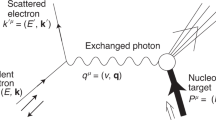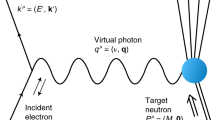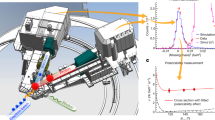Abstract
The strong interaction is not well understood at low energies or for interactions with low momentum transfer. Chiral perturbation theory gives testable predictions for the nucleonic generalized polarizabilities, which are fundamental quantities describing the nucleon’s response to an external field. We report a measurement of the proton’s generalized spin polarizabilities extracted with a polarized electron beam and a polarized solid ammonia target in the region where chiral perturbation theory is expected to be valid. The investigated structure function g2 characterizes the internal spin structure of the proton. From its moments, we extract the longitudinal–transverse spin polarizability δLT and twist-3 matrix element and polarizability \(\overline{{d}_{2}}\). Our results provide discriminating power between existing chiral perturbation theory calculations and will help provide a better understanding of this strong quantum chromodynamics regime.
This is a preview of subscription content, access via your institution
Access options
Access Nature and 54 other Nature Portfolio journals
Get Nature+, our best-value online-access subscription
$29.99 / 30 days
cancel any time
Subscribe to this journal
Receive 12 print issues and online access
$209.00 per year
only $17.42 per issue
Buy this article
- Purchase on Springer Link
- Instant access to full article PDF
Prices may be subject to local taxes which are calculated during checkout




Similar content being viewed by others
Data availability
The primary experimental data involved in the findings of this analysis are available in the tables and source data files of this Article, with additional data available on request from K.S. (karl.slifer@unh.edu), D.R. (david.ruth@unh.edu) and J.P.C. (jpchen@jlab.org). Source data are provided with this paper.
Code availability
All the computer codes that support this analysis are available on request from K.S. (karl.slifer@unh.edu), D.R. (david.ruth@unh.edu) and J.-P.C. (jpchen@jlab.org).
References
Feynman, R. P. Very high-energy collisions of hadrons. Phys. Rev. Lett. 23, 1415–1417 (1969).
Amarian, M. et al. Measurement of the generalized forward spin polarizabilities of the neutron. Phys. Rev. Lett. 93, 152301 (2004).
Sulkosky, V. et al. Measurement of the generalized spin polarizabilities of the neutron in the low-Q2 region. Nat. Phys. 17, 687–692 (2021).
Zheng, X. et al. Measurement of the proton spin structure at long distances. Nat. Phys. 17, 736–741 (2021).
Bjorken, J. D. Asymptotic sum rules at infinite momentum. Phys. Rev. 179, 1547–1553 (1969).
Drell, S. D. & Hearn, A. C. Exact sum rule for nucleon magnetic moments. Phys. Rev. Lett. 16, 908–911 (1966).
Alekseev, M. G. et al. The spin-dependent structure function of the proton \(g_1^{\mathrm{p}}\) and a test of the Bjorken sum rule. Phys. Lett. B 690, 466–472 (2010).
Deur, A. et al. Experimental determination of the evolution of the Bjorken integral at low Q2. Phys. Rev. Lett. 93, 212001 (2004).
Drechsel, D., Kamalov, S. S. & Tiator, L. Gerasimov-Drell-Hearn sum rule and related integrals. Phys. Rev. D 63, 114010 (2001).
Deur, A. et al. Experimental study of isovector spin sum rules. Phys. Rev. D 78, 032001 (2008).
Adolph, C. et al. Final COMPASS results on the deuteron spin-dependent structure function \(g_1^{\mathrm{d}}\) and the Bjorken sum rule. Phys. Lett. B 769, 34–41 (2017).
Drechsel, D., Pasquini, B. & Vanderhaeghen, M. Dispersion relations in real and virtual Compton scattering. Phys. Rep. 378, 99–205 (2003).
Deur, A., Brodsky, S. J. & de Téramond, G. F. The spin structure of the nucleon. Rep. Prog. Phys. 82, 076201 (2019).
Meziani, Z. E. et al. Higher twists and color polarizabilities in the neutron. Phys. Lett. B 613, 148–153 (2005).
Alarcón, J. M., Hagelstein, F., Lensky, V. & Pascalutsa, V. Forward doubly-virtual Compton scattering off the nucleon in chiral perturbation theory. II. Spin polarizabilities and moments of polarized structure functions. Phys. Rev. D 102, 114026 (2020).
Chen, J.-P. Moments of spin structure functions: sum rules and polarizabilities. Int. J. Mod. Phys. E 19, 1893–1921 (2012).
Drechsel, D. Spin sum rules and polarizabilities. AIP Conf. Proc. 1155, 3 (2009).
Bernard, V., Hemmert, T. R. & Meissner, U.-G. Novel analysis of chiral loop effects in the generalized Gerasimov–Drell–Hearn sum rule. Phys. Lett. B 545, 105–111 (2002).
Kao, C.-W., Spitzenberg, T. & Vanderhaeghen, M. Burkhardt-Cottingham sum rule and forward spin polarizabilities in heavy baryon chiral perturbation theory. Phys. Rev. D 67, 016001 (2003).
Burkardt, M. The g2 structure function. AIP Conf. Proc. 1155, 26–34 (2009).
Kao, C.-W., Drechsel, D., Kamalov, S. & Vanderhaeghen, M. Higher moments of nucleon spin structure functions in heavy baryon chiral perturbation theory and in a resonance model. Phys. Rev. D 69, 056004 (2004).
Osipenko, M. et al. Global analysis of data on the proton structure function g1 and extraction of its moments. Phys. Rev. D 71, 054007 (2005).
Zielinski, R. The \(g_2^{\mathrm{p}}\) Experiment: A Measurement of the Proton’s Spin Structure Functions. PhD thesis, Univ. of New Hampshire (2017).
CLAS Physics Database. http://clas.sinp.msu.ru/cgi-bin/jlab/db.cgi/ (2019).
Gu, C. The Spin Structure of the Proton at Low Q2: A Measurement of the Structure Function \(g_{\mathrm{p}}^2\). PhD thesis, Univ. of Virginia (2016).
Christy, M. E. & Bosted, P. E. Empirical fit to precision inclusive electron-proton cross sections in the resonance region. Phys. Rev. C 81, 055213 (2010).
Collaboration, H. C. Hall C Resonance Data Archive; https://hallcweb.jlab.org/resdata/database/
Mo, L. W. & Tsai, Y. S. Radiative corrections to elastic and inelastic ep and up scattering. Rev. Mod. Phys. 41, 205–235 (1969).
Akushevich, I., Ilyichev, A., Shumeiko, N., Soroko, A. & Tolkachev, A. POLARD 2.0 FORTRAN code for the radiative corrections calculation to deep inelastic scattering of polarized particles. Comput. Phys. Commun. 104, 201–244 (1997).
Afanasev, A. V., Akushevich, I., Ilyichev, A. & Merenkov, N. P. QED radiative corrections to asymmetries of elastic ep scattering in hadronic variables. Phys. Lett. B 514, 269–278 (2001).
Ye, Z., Arrington, J., Hill, R. J. & Lee, G. Proton and neutron electromagnetic form factors and uncertainties. Phys. Lett. B 777, 8–15 (2018).
Stein, S. et al. Electron scattering at 4 degrees with energies of 4.5-20 GeV. Phys. Rev. D 12, 1884 (1975).
Drechsel, D., Kamalov, S. S. & Tiator, L. Unitary isobar model—MAID2007. Eur. Phys. J. A 34, 69–97 (2007).
Guler, N. Measurement of Longitudinal Double Spin Asymmetries and Spin Structure Functions of the Deuteron in the CLAS EG1b Experiment. Tech. Rep. CLAS EG1b Collaboration (2012).
Fersch, R. et al. Determination of the proton spin structure functions for 0.05 < Q2 < 5 GeV2 using CLAS. Phys. Rev. C 96, 065208 (2017).
Bernard, V., Epelbaum, E., Krebs, H. & Meissner, U.-G. New insights into the spin structure of the nucleon. Phys. Rev. D 87, 054032 (2013).
Pascalutsa, V. & Phillips, D. R. Model-independent effects of Δ excitation in nucleon polarizabilities. Phys. Rev. C 68, 055205 (2003).
Thürmann, M., Epelbaum, E., Gasparyan, A. M. & Krebs, H. Nucleon polarizabilities in covariant baryon chiral perturbation theory with explicit Δ degrees of freedom. Phys. Rev. C 103, 035201 (2021).
Armstrong, W. et al. Revealing color forces with transverse polarized electron scattering. Phys. Rev. Lett. 122, 022002 (2019).
Wesselmann, F. R. et al. Proton spin structure in the resonance region. Phys. Rev. Lett. 98, 132003 (2007).
Anthony, P. L. et al. Precision measurement of the proton and deuteron spin structure functions g2 and asymmetries A2. Phys. Lett. B 553, 18–24 (2003).
Gockeler, M. et al. A lattice calculation of the nucleon’s spin dependent structure function g2 revisited. Phys. Rev. D 63, 074506 (2001).
E08-027 Møller Measurement (accessed 8 September 2015); http://hallaweb.jlab.org/equipment/moller/e08-027.html
Results of Raw Møller Measurement (accessed 8 September 2015); http://hallaweb.jlab.org/equipment/moller/2012_raw_results_archive.html
Musson, J. Functional Description of Algorithms Used in Digital Receivers. Technical Note, Jefferson Lab (2014).
Zhu, P. et al. Beam position reconstruction for the g2p experiment in Hall A at Jefferson Lab. Nucl. Instrum. Meth. A 808, 1–10 (2016).
Crabb, D. G. & Meyer, W. Solid polarized targets for nuclear and particle physics experiments. Annu. Rev. Nucl. Part. Sci. 47, 67–109 (1997).
Pierce, J. et al. Dynamically polarized target for the \(g_2^{\mathrm{p}}\) and \(g_E^{\mathrm{p}}\) experiments at Jefferson Lab. Phys. Part. Nucl. 45, 303–304 (2014).
Alcorn, J. et al. Basic instrumentation for Hall A at Jefferson Lab. Nucl. Instrum. Meth. A 522, 294–346 (2004).
Bosted, P. E. et al. Ratios of 15N/12C and 4He/12C inclusive electroproduction cross sections in the nucleon resonance region. Phys. Rev. C 78, 015202 (2008).
Acknowledgements
We would like to thank the Hall A technical staff, polarized target group, and the accelerator operators for their efforts and dedication. We would also like to thank J. M. Alarcón, V. Bernard, P. Bosted, E. Christy, A. Deur, E. Epelbaum, F. Hagelstein, H. Krebs, S. Kuhn, V. Lensky, U.-G. Meißner and V. Pascalutsa for their very helpful discussion and suggestions on this publication. This work was supported by the Department of Energy (DOE) under grants DE-FG02-88ER40410 (funding the University of New Hampshire Nuclear Physics group, received by K.S.), DE-FG02-96ER40950 (funding the University of Virginia Polarized Target Group, received by D.D.) and DE-AC02-06CH11357 (funding the Argonne National Lab group, received by P.R.). The Southeastern Universities Research Association operates the Thomas Jefferson National Accelerator Facility for the DOE under contract DE-AC05-06OR23177.
Author information
Authors and Affiliations
Contributions
All the authors were involved in the collection of data, design and commissioning of the experimental equipment, or the processing and analysis of the data. The following authors contributed especially to the main analysis and writing of this Article: D.R., J.P.C., K.S. and R.Z.
Corresponding author
Ethics declarations
Competing interests
The authors declare no competing interests.
Peer review
Peer review information
Nature Physics thanks Eva-Maria Kabuß, Salvatore Fazio and the other, anonymous, reviewer(s) for their contribution to the peer review of this work.
Additional information
Publisher’s note Springer Nature remains neutral with regard to jurisdictional claims in published maps and institutional affiliations.
Extended data
Extended Data Fig. 1 Measured spin structure function systematic uncertainties.
The results are given in %. Systematic uncertainties arise from the target dilution factor f, from beam and target polarizations Pb and Pt, radiative corrections ΔσRC and Δσtail, the g1/g2 inputs into eq. (8), and dΩdE’, the error on the unpolarized cross section model. Systematic contributions from the out of plane polarization angle θOoP and the adjustment of the structure functions to constant Q2 were evaluated and found to contribute < 1% to the total systematic error. Reported values are typical of values around the Δ(1,232) resonance. The columns indicate the systematic associated with each individual Q2 kinematic setting, as indicated in the first row. †Longitudinal kinematic setting.
Source data
Source Data Fig. 1
Main data results of the Article.
Rights and permissions
Springer Nature or its licensor holds exclusive rights to this article under a publishing agreement with the author(s) or other rightsholder(s); author self-archiving of the accepted manuscript version of this article is solely governed by the terms of such publishing agreement and applicable law.
About this article
Cite this article
Ruth, D., Zielinski, R., Gu, C. et al. Proton spin structure and generalized polarizabilities in the strong quantum chromodynamics regime. Nat. Phys. 18, 1441–1446 (2022). https://doi.org/10.1038/s41567-022-01781-y
Received:
Accepted:
Published:
Issue Date:
DOI: https://doi.org/10.1038/s41567-022-01781-y



